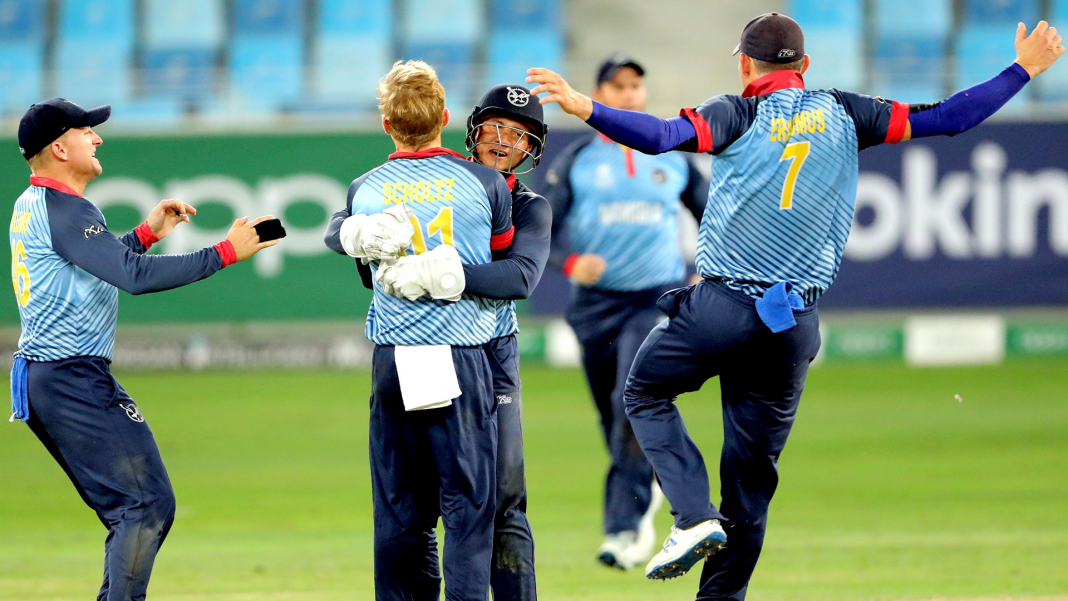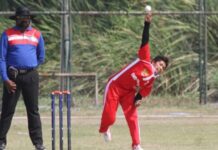After powering through the qualifiers in 2019, and enduring a fallow period during the pandemic in 2020, Namibia’s young team has spent the better part of six months preparing for this year’s biggest assignment.
In a busy home summer, head coach Pierre de Bruyn rotated through 20 players across 26 matches against five different teams as Windhoek played host to development sides from South Africa and Zimbabwe, Uganda’s first XI and the Titans provincial franchise from South Africa. The Namibians also travelled to Bloemfontein for a T20 series against the Knights. In that time, some have staked convincing claims in key positions, but there remain numerous question marks over who fills out the side.
With wicket-keeper Zane Green locked in for one of the opening places, longtime opener Stephan Baard looks like the leading contender to join him at the top. Less of a power hitter, he possesses a compact game that can complement Green’s frenetic approach, though one-dayers are his stronger format and his outing at the qualifiers in 2019 was also disappointing (scoring 152 runs in 7 innings at 21.7 and a sluggish strike rate of 105.5), so a possible alternative at the top would be veteran allrounder Craig Williams.
Williams often bats at 3 and has both more experience at pacing an innings and an extra gear of acceleration compared with Baard; across a more than 15-year career with the Eagles, he has played 95 official T20s with a strike rate of 131. In 13 outings at home this season he hit four half-centuries and 401 runs at 30.8 with a strike rate of 125.6, keeping ahead of the opposing run rate seven times, though he was also dismissed five times for 10 or under. More likely is that Namibia will play both Baard and Williams, looking to make up the run rate with big hitters down the order.
Who joins Gerhard Erasmus in the middle order will be one of Pierre de Bruyn’s more difficult decisions, with six players trialled this season in the number 5 slot, and none claiming it comprehensively. One of the leading candidates appears to be Michael van Lingen, an all-rounder who also bowls tidy medium pace, though he impressed more in the 50-over matches (6 innings, 276 runs at 55.2, SR 95.8, a century and two fifties) than in the T20s (9 innings, 119 runs at 17, SR 104.4).
As a technically solid batter who looks more comfortable with the accumulate-then-accelerate method than hitting from ball one, van Lingen may play a floating role where he is sent in to consolidate if Namibia run into trouble early, but yields to their power-packed finishers if the top order tees off.
While JJ Smit is a shoo-in for the lower-order finisher role with the bat, he is also a key part of Namibia’s bowling plans – a canny left-arm seamer who took 16 wickets in the 2019 qualifier, the most for Namibia at the tournament. He returned from a knee injury during the home season, first as a specialist batter then steadily bowling himself into form. His overall figures are mediocre (30 overs, 11 wickets at 22.36, 8.2 RPO), but his rhythm improved as he got through more overs, tightening his action and finding the back-of-a-length area that, at his best, allows him to catch batters in two minds and cut it off the pitch.
Over Namibia’s last two series (home to the Titans and away to the Knights), he bowled 20 overs and took 9 wickets at 15.2 and 6.8 RPO. In four of his six outings, his economy rate was lower than the opposition’s (that is, he kept opposing batters to a lower run rate than Namibia’s).
Another left-armer is the experienced Jan Frylinck, who prefers to bowl fuller and make the most of any swing available with the new ball. The approach is an incisive contrast to Smit and pace spearhead Ruben Trumpelmann, with Frylinck taking 14 wickets in 41 overs at 17.6 and 6.4 RPO, though his lower speed leaves him eminently hittable if the ball doesn’t swing early. He was also crucial in 2019 where he grabbed 15 wickets in 7 matches at 10.4 and 6.2 RPO. A handy bat too, Frylinck hit 130 runs (including 7 sixes) in 9 lower-order innings this season with a strike rate of 139.8.
Other seam options at Erasmus’ disposal include skiddy right-armer Ben Shikongo, Michael van Lingen’s left arm mediums, allrounder Karl Birkenstock, and of course T20 franchise star David Wiese. Craig Williams is another who can offer useful fast-mediums, but having bowled just 7 overs in 13 matches, it seems that in the twilight of his career his duties with the ball will be minimal.
Joining lead tweaker Bernard Scholtz as a spin option could well be Pikky Ya France, who has reinvented himself in recent years – early in his career he was known as a stodgy top-order bat in Namibia’s multiday campaigns (nicknamed in some quarters “the Associate Chris Tavaré”), but he has since opened up his batting and worked on his bowling to become an effective utility player in the short formats, offering great flexibility to the team composition.
Hitting harder now from the same technically sound base he can immediately work the gaps and scamper quick runs at the death, as well as striking effectively down the ground and through the offside. In 8 innings this season he hit 102 runs for 3 times out at 141.7 SR. His bowling is deceptive, slow off-spin delivered with a flourishing action and a knack for partnership-breaking wickets – he picked up 12 dismissals in 20 overs at 11.2, going at 6.7 RPO and below the opposition more than half the time.
Elsewhere on the spin front, Erasmus often bowls his own off-spin to break up the batting side’s rhythm and winkle out a wicket or a cheap over – a calculated risk that can result in him being taken to the cleaners, but it paid off more often than not in Namibia’s home series as he took 9 scalps at 14.6 in 21 overs and 6.3 RPO; he was below the opposition 7 of 10 outings.
The other spin option, having emerged in the last year or so, is legspinning allrounder Jan-Nicol Loftie-Eaton, who enters is one of the tournament’s most exciting young players. Loftie-Eaton is a fastish legspinner, somewhat reminiscent of Rashid Khan, who delivers serious turn and bamboozling variations. A recent alumnus of the impressive Namibian U19s production line (which fast-tracks talented youth into the top division of club cricket to gain experience), 20-year-old Loftie-Eaton is amongst the most exciting prospects in Associate cricket.
As well as being a genuine wicket-taking threat, he oozes talent with the bat, possessing both the power to hit balls long over the boundary and creativity to improvise all manner of sweeps, ramps, paddles and reverses. He burst onto the scene last year with two unbeaten centuries on semi-finals day of Namibia’s Richelieu T20 franchise league to claim second place on the overall run charts at a strike rate of 220.3 (despite playing only three matches), then he topped the wicket tally in this year’s second edition (whilst also reaching fifth in the runs count at the second-highest strike rate of 175.4).
That said, he struggled to find his niche over Namibia’s home series, shuffling up and down the order and recording just 144 runs at 14.4 in 13 innings (at a strike rate of 112.5); he is a hyperactive presence at the crease and he frequently succumbed to brain snaps and indecision in choosing between his range of strokes. If he can ally patience with his natural flair he will be a truly dangerous prospect.
Likely competing with Michael van Lingen or Pikky Ya France for an all-rounder’s place in the middle order, he had more success with the ball, collecting 9 wickets in 26.2 overs at 19 and 6.5 RPO, so if pitches are conducive to turn he will offer a compelling option for Namibia.
Best XI (predicted): Zane Green (wk), Stephan Baard, Craig Williams, Gerhard Erasmus (c), Michael van Lingen/Jan-Nicol Loftie-Eaton, JJ Smit, David Wiese, Jan Frylinck, Pikky Ya France/Ben Shikongo, Ruben Trumpelmann, Bernard Scholtz.







